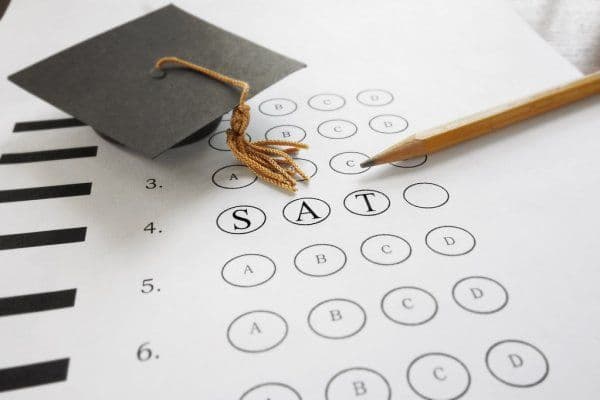
PSAT: Everything You Need To Know
The PSAT (Preliminary SAT) is a standardized test sponsored by both the College Board, who write and administer it, and the National Merit Scholarship Corporation. Here's what you need to know!

This blog post was originally published on January 26, 2023 and has been republished with updated information.
Most schools in New York City automatically register 11th graders for the October PSAT exam, which is given in school during regular class time. In other words, the test is more or less mandatory. About 1.6 million 11th graders take the PSAT every year in the U.S. With nearly 4 million 11th graders in total across the country, this equates to roughly 40% of students taking the PSAT nationwide.
Many schools are now also giving the PSAT in the 9th grade and 10th grades. Students who have taken the PSAT two or three years in a row without studying for it, may find it interesting to see their progress throughout the years. This should happen naturally, even without any prep. But the 11th grade PSAT is the “real” thing (not practice for the PSAT which is what taking the test in 9th or 10th grade really is) and that’s the one we’ll be discussing below.
What is the PSAT?
The PSAT (Preliminary SAT) is a standardized test sponsored by both the College Board, who write and administer it, and the National Merit Scholarship Corporation. Its content and structure is very similar to the SAT, testing students’ skills in reading, writing, and math, though it contains fewer questions and is slightly easier than the real SAT.
Why do you need to take the PSAT?
As its name suggests, the PSAT is designed to help prime students before they take the SAT. It also is used as the qualifying test to identify National Merit Scholars and determine the recipients of National Merit scholarship money. As such, it is a useful benchmark as you prepare for the SAT, as well as a potential boost to your college admissions experience.
The 11th grade PSAT matters if you think you can score in the top 1% and qualify for a National Merit Scholarship, and it also matters as a benchmark for your progress. Because ACT and SAT scores are still a key component of the college application at most colleges and universities, it’s important to get a benchmark score to see where you are now vs. where you want your score to be by the beginning of 12th grade (at the latest!), when college application deadlines start to roll in. It happens all too often that fantastic, 4.0 GPA students are not the best test-takers, so while they may be aiming for top tier and Ivy League colleges and universities given their grades, these students can be shocked to get a PSAT score that does not seem to “match” their GPA. It’s good to know if there is a discrepancy between a students' grades and test scores as soon as possible so they can start learning to be better test takers.
One last reason why you may need PSAT is if a student wants to apply to the Johns Hopkins Center for Talented Youth summer programs, which accept PSAT scores as a qualifier for entry.
Every year, our tutors work with students for whom the skill of test-taking doesn’t come naturally and turn them into test-taking whizzes. It’s a skill that can be learned and learning that skill as early as possible will help for future exams in college and even when applying to grad school. We're also pros at working with high-performing test takers to raise scores to the high 1500s and even get a perfect 1600.
What is the National Merit Scholarship Corporation or NMSC?
NMSC is a nonprofit organization that is not affiliated with the government or with the College Board. It was established in 1955 as a competition to identify the brightest students and match them with funding to attend top colleges and universities.
While National Merit Scholarships contribute only $2,500 per year in actual money, they are VERY prestigious and being a National Merit Scholar really makes an application stand out. Besides the $2,500 grant, NMSC also facilitates scholarships through certain philanthropic companies and through colleges themselves.
Between finalists, semi-finalists and special grants, NMSC gives about 10,000 grants annually. With less than 1% of students who take the PSAT becoming National Merit Scholars, students will likely have to start studying for the test in 10th grade or in the summer between 10th and 11th grade to make the cut.
What grades take the PSAT?
Since the PSAT is designed to be taken before the SAT, it is taken primarily by high school sophomores and juniors, though some schools also offer it to freshmen. Note that only juniors who take the test are considered for National Merit Scholarships.
When is the PSAT?
To find out more about the PSAT/NMSQT at your school, contact your principal or counselor. PSAT/NMSQT testing may occur on a school day between these dates:
- October 1–October 31, 2025
- Schools may also choose to administer the PSAT/NMSQT on Saturday, October 11, 2025, or Saturday, October 18, 2025.
How long is the PSAT?
The PSAT is 2 hours and 14 minutes, making it just 10 minutes shorter than the real SAT.

PSAT Structure
What is the format of the PSAT?
The PSAT is formatted similarly to the SAT, but with only one module per section instead of two. Students take one Reading and Writing section and one Math section. The PSAT does not have an essay component of any kind. Most of the PSAT is multiple choice, though each of the math sections includes four grid-in questions as well.
What is on the PSAT?
Like the SAT, the PSAT is meant to test skills that students are learning in school. The reading and writing sections will test things like a student’s vocabulary, their ability to understand and find evidence in passages, their understanding of grammar and punctuation, their ability to interpret data, and their ability to improve the structure and style of passages. The math sections draw primarily upon algebra, data analysis, geometry, and some more advanced material such as trigonometry.
PSAT Sections
Reading & Writing
The Reading and Writing section on the PSAT is 60 minutes long. It has 47 multiple choice questions covering five passages, which draw from literature, historical documents, social sciences, and the natural sciences. This section primarily aims to test a student’s reading comprehension, their ability to identify evidence, their command of vocabulary in context, and their reasoning skills.
Writing and Language
The Writing and Language section on the PSAT is 35 minutes long. It has 44 multiple choice questions, primarily drawing from non-fiction passages. This section is meant to test a student’s understanding of grammar and punctuation, as well as how to structure arguments for optimal clarity and logic.
Math
The two math sections together are 70 minutes (25 minutes without a calculator, and 45 minutes in which a calculator is permitted). They have 48 total questions, several of which are grid-ins, but most of which are multiple choice. Topics that may be covered include: linear equations, inequalities, nonlinear expressions, data analysis, functions, geometry, trigonometry, and complex numbers.
How many questions are on the PSAT?
There are 139 total questions on the PSAT: 47 Reading, 44 Writing and Language, 17 Math (No Calculator), and 31 Math (Calculator).
PSAT Registration
How to register for the PSAT?
For most students, registration for the PSAT will be managed through their school’s counseling office, either online or in person. This is true for any student whose high school offers the PSAT. For students who cannot register for a test at their school, particularly international or homeschooled students, the College Board offers a school search tool to find schools that are offering the test. If you are planning to take the PSAT at a school other than your own, call the school by May of the year you plan to take the test to discuss registration.
What is the PSAT registration fee?
The PSAT registration fee is currently $18 (not including any administration fees your school might additionally require). Some schools cover the registration fees, and 11th graders who meet income criteria may qualify for fee waivers. Consult the counseling office at your testing location to better understand what fees you are responsible for.
When is the deadline for PSAT registration?
The registration deadline for the PSAT depends on the school administering it. Contact your school (or the school at which you intend to take it) to find out what their registration deadline is. Please note that if you intend to request testing accommodations of any kind, you must contact the school to request these accommodations by the third week of August.
How to cancel PSAT registration?
Cancellation of PSAT registration is navigated through the administering school, so you’ll have to contact your school’s counseling office to determine if you can cancel, and how. Note that if your school allows you to cancel your registration and get your money back, you’ll need to request this before mid-September, since this is the cutoff date for the school to order testing materials.
PSAT Test Day
What to bring to PSAT?
You don’t need to bring much to the PSAT. All you really need is No. 2 pencils with erasers and an approved calculator, and a face covering if the testing school requires it. You might also want to bring a drink or snacks for the break, but you cannot have these out during the test. If you want to bring a watch, make sure it is not a smartwatch and does not have an audible alarm. Similarly, if you have a phone in your backpack, it must be turned fully off.
PSAT Scoring
The band of possible scores for the PSAT is slightly narrower than the SAT, with the highest possible score at 1520. Like the SAT, this total score is a sum of the two major section scores – one for Reading and Writing and one for Math – each of which is in the range 160-760. These section scores are based on your raw score and a scaling system which adjusts for variations in the difficulty of different versions of the test. You will also receive subscores, ranging from 1-15, reflecting your performance in specific skill areas: command of evidence, words in context, expression of ideas, grammatical conventions, algebra, problem solving and data analysis, and preparation for advanced math.
What is an average PSAT Score?
The average PSAT score among 10th graders in the past three school years has been 920, and among 11th graders has been 1010. Scores of above 1180 and 1280 have placed students in 10th and 11th grades, respectively, in the top 10% of test takers in this same time period.
How to get your PSAT scores?
PSAT scores are usually available online 4-6 weeks after you take the test. On the day of the test, your answer sheet will have space for you to provide your email address. If you do so, you will receive a notification email when the scores are available. Whether or not you provided an email address, you can access your scores via your CollegeBoard account.
PSAT FAQs
How many times can you take the PSAT?
You can take the PSAT up to three times total, but only once per year, between your freshman and junior years of high school.
Can you fail the PSAT?
No, you cannot fail the PSAT. Students may be overjoyed by scoring in the top 10%, even if they are not great students in school. Or they may be disappointed if their PSAT score doesn’t match their abilities or GPA, but there is no failing (or even passing) the test.
What if you fail PSAT?
There are no significant negative consequences to performing poorly on the PSAT. These scores will not be reported to colleges, so they will not negatively impact your admissions processes. The only downside – if you get a low score in your junior year specifically – is that you will not be considered for scholarships like National Merit, which use the PSAT scores as qualifying metrics. However, you also won’t be considered for these scholarships if you do not take the PSAT, so fear of a poor performance is no reason not to take the test. The benefits of taking it – namely, giving you a good indication of what and how much you’ll need to study for the SAT – make taking the test well worth the experience, no matter how well you do.
What happens if you skip a PSAT?
There are no consequences to skipping a PSAT. Know, however, that the test is only offered once a year, so you have limited opportunities to take it. Furthermore, you must take it during your junior year if you want to be considered for scholarships like National Merit.
Do colleges care if you take the PSAT?
PSAT scores are not reported to colleges, so taking the test does not directly impact your college admissions journey. However, if you do well on the PSAT, you can qualify as a National Merit Scholar, which can be a boost to your applications.
Can you get into college without taking the PSAT?
Absolutely yes, you can get into college without taking the PSAT. PSAT scores are not reported to colleges, so taking the PSAT is not a requirement for any college admissions process. That being said, if you plan on taking the SAT, the PSAT is a helpful tool to guide your studying, so taking it can ultimately help your admissions journey.
Does the PSAT affect your GPA?
No, PSAT does not affect your GPA.
Can I get scholarships if I do well on the PSAT?
Yes, you can get a scholarhsip if you do well on the PSAT. A variety of scholarship funds, most notably National Merit, use PSAT scores as the metric to determine qualification. What score you need to become a National Merit scholar will depend on the state in which you live, and can vary year to year, as advancing to semi-finalist status is based on the top scoring students in your state. Becoming a National Merit finalist will also depend on your SAT or ACT scores, but performing well on the PSAT is a good indication that you are also prepared to do well on the SAT or ACT.
When should I start studying for the PSAT?
When and whether you should start studying for the PSAT depends on what grade you are in. If you are taking it in your freshman or sophomore year, there is no real need to study, as you will have future opportunities to take it and your scores in these years will not impact your National Merit qualification. We recommend starting to study for the PSAT no later than the summer before your junior year, which will give you a few months to prepare for the PSAT and help prepare you for taking the SAT or ACT later in the school year.
How to study for PSAT? 8 Tips from Ivy Tutors
1. Learn about the format and the scoring
For any standardized test, it’s a good idea to know what to expect so you don’t run into any surprises on testing day, and so you can understand your scores.
2. Set goal scores for both the PSAT and SAT
If you’re using the PSAT as a preparatory benchmark for the SAT, it’s good to have an idea of what SAT scores you’ll need to get into the colleges you’re interested in, and what PSAT score would indicate that you’re “on track” for your SAT goal score. Moreover, if you’re pursuing National Merit Scholarship, it’s important to know what scores you’ll need to get there.
3. Take PSAT practice tests
The best tool for studying for any standardized test is to take official practice tests. This will help you get used to the testing experience, and will be the best indicator of what areas you need to work on.
4. Understand your mistakes
Remember that failure is a tool for success! As you study and take practice tests, try to analyze why your incorrect answer choices are wrong and how you could determine the correct answer in the future.
5. Find patterns in your mistakes
Pay attention to what you consistently get wrong. This is a good indicator of what content areas you need to review more thoroughly.
6. Use SAT practice resources
There aren’t as many official tests or practice resources for the PSAT as there are for some other standardized tests. Luckily, since the PSAT is modeled after the SAT, SAT resources are also a great way to prepare for the PSAT.
7. Start studying early
Especially if you’re hoping to be a National Merit semi-finalist or finalist, you want to give yourself ample time to prepare.
8. Study in small, frequent sessions
The best way to consistently and effectively improve is to review often, a little bit at a time.
If you're hoping to qualify for National Merit and other scholarships, consider working with a tutor. At Ivy Tutors Network, our experienced PSAT tutors know the best tips and tricks for excelling on the exam, helping you to reach your target score, qualify for National Merit, and get into the school of your dreams!




